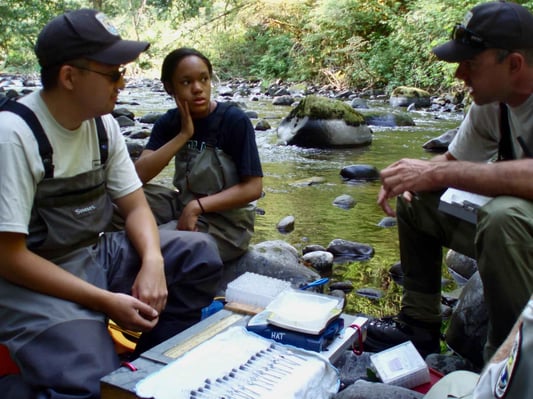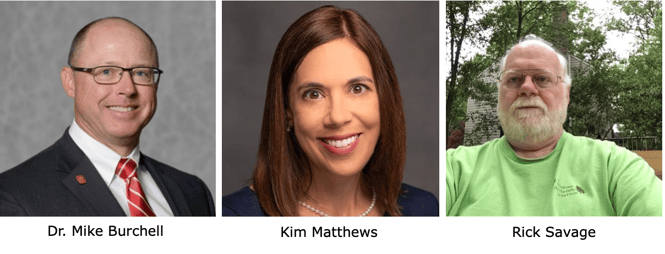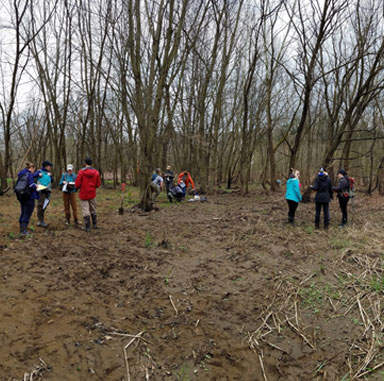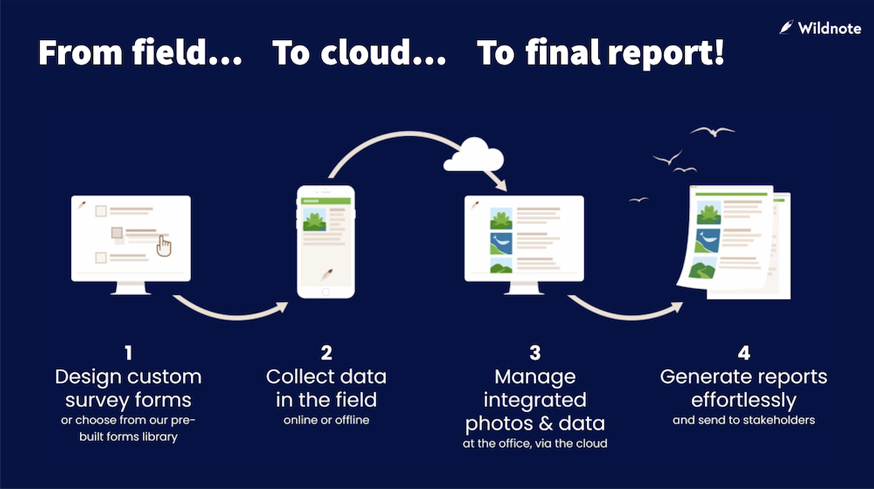Sustainable Wetland Monitoring in North Carolina Restored by Volunteers
After shifting political winds blew one of the country’s most notable wetland monitoring programs off the table in 2014, Dr. Mike Burchell, The Carolina Wetlands Association (the Association), RTI International, the EPA, and others, teamed up to put the pieces back together. Now they are pairing volunteers with technology in a pioneering move to rebuild a sustainable wetland monitoring program that could serve as a model elsewhere. Wildnote sat down with Association Executive Director, Rick Savage, to find out more about this innovative program.
Wildnote: Who came up with the program idea and why use volunteers?
Rick: Neither North Carolina (NC) nor South Carolina (SC) have a state-funded wetland monitoring program. Both states use grant-funding from the Environmental Protection Agency (EPA) to conduct project-specific wetland monitoring. The NC program was considered one of the best wetland monitoring programs in the US. In 2014, the program abruptly ended due to a change in the state administration and election of a new governor. North Carolina State University (NCSU) professor Dr. Mike Burchell received EPA funding to continue monitoring a subset of NC’s wetland monitoring sites for several years. A conclusion from that study was that the state needed to find another way to develop a sustainable wetland monitoring program in NC. Dr. Burchell, in partnership with the Association and RTI International, approached the EPA to fund the North Carolina Volunteer Wetlands Monitoring Program. One of the main reasons the EPA selected our project was the use of volunteers/citizen scientists to monitor wetlands.
Wildnote: How did you choose which wetlands would be in the study?
Rick: We decided early on to concentrate on wetlands that were relatively undisturbed and of good quality that could potentially serve as reference sites. We then decided to select sites from the wetlands recognized as Wetland Treasures of the Carolinas by the Association because they are mostly protected from human impacts. Finally, since the principal investigators are based in Raleigh, NC, we chose the three wetlands in close proximity for our pilot program. The three wetland sites are found at Robertson Mill Pond, Hemlock Bluffs Nature Preserve, and Mason Trail Biological Reserve. If our pilot Volunteer Wetlands Monitoring Program can be successfully established, we intend to expand to other Wetland Treasures.
Wildnote: When will the fieldwork begin?
Rick: We expect to start monitoring in February/March 2022 where we would be taking water quality samples, recording hydrology data, and conducting amphibian surveys. Some training will occur before then, but much of that training will be field based.
Wildnote: Have you done this with volunteers in the past?
Rick: No, this is our first time and we have a lot to learn. We are taking small steps to get the program going in the right direction. A team of experienced principal investigators from the Association, NCSU, and RTI International will manage the data collection process, assist volunteers, and analyze the data collected by the volunteers.

Wildnote: What is different about working with volunteers instead of professionals on this type of project?
Rick: The main difference is that more volunteers need more training and supervision. Since we have not really started the program, there are a lot of additional differences to be realized, but I will say that the people who have volunteered so far are really excited about doing the work and the enthusiasm is most exciting to see. If we do this right, the volunteers know the data being collected will be used to inform wetland decisions and then the motivational levels are likely to remain high.
Wildnote: Will each volunteer do every type of sampling, or will they focus on separate areas?
Rick: They will have the option of how they want to participate, but we think most volunteers will focus on a specific wetland site. We will provide the training by type of samples and match volunteers with their preferred activities.
We will determine that mostly on their interests, but we will need basic data collected during each site visit and we want them to experience as much of the sampling as possible. I feel that we will encourage everyone to learn all of the sampling procedures, but then let interests dictate where the volunteers may concentrate, as long as we have all the needed sampling procedures done.
Wildnote: How did you recruit the volunteers?
Rick: We are starting with our current supporters of the Association and then use the network of volunteers that support our selected wetlands sites. We will solicit through our partner organizations such as the NC Wildlife Federation and NC Herpetological Society, and advertise through our newsletter, social media channels, and in-person events. We participated in the Good Hope Farm Fall Festival in Cary and got several volunteers from that event. We probably already have more than enough volunteers to get started, but if not, we will advertise further. We have hired a Volunteer Coordinator to help organize our volunteers and more importantly keep them engaged and coming back to help again and again.
Wildnote: What is the volunteer makeup? Age range, backgrounds, etc.
Rick: They are very diverse in age and backgrounds. We have quite a few volunteers that we are considering to be mentors because they have some experience conducting this kind of work. We have interest from college-age students to retirees. Once we formally “induct” them into the monitoring program, we will know more about how diverse the volunteers are.
Wildnote: How are they getting trained to monitor wetlands?
Rick: We will have written standard operating procedures (SOPs) and instructional materials for volunteers to use for guidance. Volunteers will be required to attend training before conducting actual sampling. Training will start as in-person sessions but could transition to on-demand videos – so the training is anticipated to become more robust with time.

Wildnote: How were the Principal Investigators selected?
Rick: We went with the three organizations and the three wetland scientists who have been doing this work for years and who came up with the idea – Dr. Mike Burchell with NCSU, Kim Matthews with RIT international, and myself, Rick Savage with Carolina Wetlands Association, formally with the NC Department of Environment and Natural Resources.
Wildnote: Why did you decide to use Wildnote?
Rick: In developing the monitoring program, we had been trying to determine how to make data collection easier for volunteers and ensure collection of good-quality data. The Wildnote platform will help us achieve both goals.
After several meetings with Wildnote, it just seemed to be a good way for everyone to learn more and expand the possibilities of all involved. We clearly expect to work with Wildnote in ecological assessments – and Carolina Wetlands Association just got a grant to come up with a restoration plan for the Stony Run watershed in Harnett County, NC. That project will involve an extensive ecological assessment and Wildnote would potentially be a good fit for that. The Association has worked closely with Nancy Douglas at Wildnote to discuss how we want to collect and analyze data for the project. She was an essential part of the process to determine how data will be collected for the project by taking our ideas and finding the best ways to incorporate Wildnote. Because Wildnote is so versatile, we were able to develop our own data forms to collect project-specific data.

Wildnote: What are the benefits of using digital technology on this type of project?
Rick: Less paper, more accuracy, better data management, and we feel that volunteers will be even more enthusiastic by learning to use these applications.
Wildnote: Did you have to do any special preparation in order to use Wildnote for this project?
Rick: We had to decide what type of data we wanted to collect and how we wanted to collect it. Online resources, manuals, protocols, and standards were reviewed to determine how to collect data that can be informative and duplicated at a state and national level if the project were to expand across NC and to other states. Helpful reference text and predetermined lists were created and included in the data forms to facilitate data collection for the volunteers. We are learning how to best integrate Wildnote into our data collection efforts given that we had already decided on using iNaturalist for species identification needs. However, the opportunity to work with Wildnote was an opportunity that could not be passed up. We are using both platforms at the same time and will refine our methods over time based on feedback from our volunteers and data evaluation.
Wildnote: What are the differences between iNaturalist and Wildnote, and why use both?
Rick:
iNaturalist is a collaborative social network whereas Wildnote is a business solution.
iNaturalist allows users to create projects for data collection, record biological observations, assist others with species identification, and stay connected through journal posts. iNaturalist will be an effective tool to aid in species identification for the volunteers and is quite honestly fun to use. When adding photo observations, iNaturalist offers a list of visually similar species that have been recorded nearby and the observer can compare photos of the suggested species. Once an observation is uploaded, other users of iNaturalist can agree with the species identification or suggest a different species. In iNaturalist, a separate vegetation, amphibian, and general wildlife project was created for each wetland monitoring site. iNaturalist will also be used to communicate and engage with volunteers prior to and following site visits.
There is a possibility to transfer data from iNaturalist into Wildnote or vice versa; however, in order to reduce the possibility of errors when transferring data between platforms, it was determined to keep the species identifications and associated data in iNaturalist during site visits.
The Wildnote platform is a business solution used to collect, manage, and report field data on a project basis. Through Wildnote, customized data forms were created to collect project-specific data not associated with specific species observations, such as general site conditions and water quality data. Furthermore, iNaturalist cannot be used as a mapping tool, which will be needed for this project. Wildnote will be used to map, photograph, and record data for plant communities and invasive species occurrences. Wildnote is designed to keep data attached to photos, eliminating the need to format, label, email or otherwise manipulate photos for reports.
Wildnote: We are very excited to be a part of this great effort to restore the Carolina wetlands monitoring program and hope for a successful pilot project with more to follow.
Find out more about Carolina Wetlands Volunteer Monitoring Program and the other great work being done to conserve, restore, and monitor wetlands in the Carolinas.
Experience the joy of a compliance monitoring workflow that works - so you can Go Fast and Get it Right

Senior PWS and Swamp School Founder, Marc Seelinger, is excited about the changes ahead.
“The Swamp School is committed to providing a cutting-edge education for modern wetland scientists, who expect technology solutions to better their work. Wildnote elevates our curriculum, making the Swamp School the only wetland training program in the U.S. to offer a mobile technology component. We look forward to working with Wildnote to help our students perform more accurate and reliable delineations and to advance the state of the art in wetland evaluation technology.”
- Marc Seelinger

Senior PWS and Swamp School Founder, Marc Seelinger, is excited about the changes ahead.
“The Swamp School is committed to providing a cutting-edge education for modern wetland scientists, who expect technology solutions to better their work. Wildnote elevates our curriculum, making the Swamp School the only wetland training program in the U.S. to offer a mobile technology component. We look forward to working with Wildnote to help our students perform more accurate and reliable delineations and to advance the state of the art in wetland evaluation technology.”
- Marc Seelinger

Swamp School class engaged in field training
The Swamp School
Based in Angier, North Carolina, the Swamp School offers post-secondary/college classes and webinars in wetland assessment, delineation and design, and other topics relating to the management of wetlands. The classes are designed to help environmental professionals enhance their skills and expand their business. Wildnote will be included in all of the Swamp School’s wetland delineation courses, whether offered in the classroom, online or on-demand sessions.
TEST Automated Forms with Professional Wetland Training
The Swamp School has the ability to provide the wetland and IT technical support that students need to successfully use technology to collect data and report on wetland delineations. Marc pointed out that many of the issues with the wetland delineation data collection software products arise not from an inability to use the software but from a fundamental misunderstanding of what data needs to be collected, how, and why. By combining the wetland training with the software training, students will seamlessly integrate digital technology into their delineation projects. The newly-formed partnership was immediately put to use.

Senior PWS and Swamp School Founder, Marc Seelinger, is excited about the changes ahead.
“The Swamp School is committed to providing a cutting-edge education for modern wetland scientists, who expect technology solutions to better their work. Wildnote elevates our curriculum, making the Swamp School the only wetland training program in the U.S. to offer a mobile technology component. We look forward to working with Wildnote to help our students perform more accurate and reliable delineations and to advance the state of the art in wetland evaluation technology.”
- Marc Seelinger

Senior PWS and Swamp School Founder, Marc Seelinger, is excited about the changes ahead.
“The Swamp School is committed to providing a cutting-edge education for modern wetland scientists, who expect technology solutions to better their work. Wildnote elevates our curriculum, making the Swamp School the only wetland training program in the U.S. to offer a mobile technology component. We look forward to working with Wildnote to help our students perform more accurate and reliable delineations and to advance the state of the art in wetland evaluation technology.”
- Marc Seelinger

The Wildnote process integrates and streamlines data from the field to final report
Choosing Wildnote for a Wetland Technology Partner
Seelinger spent years looking for the right technology to integrate into the curriculum. He said he chose Wildnote because it is a complete platform that supports the entire process of wetland data collection, management, and reporting.

Senior PWS and Swamp School Founder, Marc Seelinger, is excited about the changes ahead.
“The Swamp School is committed to providing a cutting-edge education for modern wetland scientists, who expect technology solutions to better their work. Wildnote elevates our curriculum, making the Swamp School the only wetland training program in the U.S. to offer a mobile technology component. We look forward to working with Wildnote to help our students perform more accurate and reliable delineations and to advance the state of the art in wetland evaluation technology.”
- Marc Seelinger

Senior PWS and Swamp School Founder, Marc Seelinger, is excited about the changes ahead.
“The Swamp School is committed to providing a cutting-edge education for modern wetland scientists, who expect technology solutions to better their work. Wildnote elevates our curriculum, making the Swamp School the only wetland training program in the U.S. to offer a mobile technology component. We look forward to working with Wildnote to help our students perform more accurate and reliable delineations and to advance the state of the art in wetland evaluation technology.”
- Marc Seelinger

The Wildnote process integrates and streamlines data from the field to final report
Choosing Wildnote for a Wetland Technology Partner
Seelinger spent years looking for the right technology to integrate into the curriculum. He said he chose Wildnote because it is a complete platform that supports the entire process of wetland data collection, management, and reporting.

Swamp School class engaged in field training
The Swamp School
Based in Angier, North Carolina, the Swamp School offers post-secondary/college classes and webinars in wetland assessment, delineation and design, and other topics relating to the management of wetlands. The classes are designed to help environmental professionals enhance their skills and expand their business. Wildnote will be included in all of the Swamp School’s wetland delineation courses, whether offered in the classroom, online or on-demand sessions.
Automated Forms with Professional Wetland Training
The Swamp School has the ability to provide the wetland and IT technical support that students need to successfully use technology to collect data and report on wetland delineations. Marc pointed out that many of the issues with the wetland delineation data collection software products arise not from an inability to use the software but from a fundamental misunderstanding of what data needs to be collected, how, and why. By combining the wetland training with the software training, students will seamlessly integrate digital technology into their delineation projects. The newly-formed partnership was immediately put to use.

Senior PWS and Swamp School Founder, Marc Seelinger, is excited about the changes ahead.
“The Swamp School is committed to providing a cutting-edge education for modern wetland scientists, who expect technology solutions to better their work. Wildnote elevates our curriculum, making the Swamp School the only wetland training program in the U.S. to offer a mobile technology component. We look forward to working with Wildnote to help our students perform more accurate and reliable delineations and to advance the state of the art in wetland evaluation technology.”
- Marc Seelinger

Senior PWS and Swamp School Founder, Marc Seelinger, is excited about the changes ahead.
“The Swamp School is committed to providing a cutting-edge education for modern wetland scientists, who expect technology solutions to better their work. Wildnote elevates our curriculum, making the Swamp School the only wetland training program in the U.S. to offer a mobile technology component. We look forward to working with Wildnote to help our students perform more accurate and reliable delineations and to advance the state of the art in wetland evaluation technology.”
- Marc Seelinger

The Wildnote process integrates and streamlines data from the field to final report
Choosing Wildnote for a Wetland Technology Partner
Seelinger spent years looking for the right technology to integrate into the curriculum. He said he chose Wildnote because it is a complete platform that supports the entire process of wetland data collection, management, and reporting.

Senior PWS and Swamp School Founder, Marc Seelinger, is excited about the changes ahead.
“The Swamp School is committed to providing a cutting-edge education for modern wetland scientists, who expect technology solutions to better their work. Wildnote elevates our curriculum, making the Swamp School the only wetland training program in the U.S. to offer a mobile technology component. We look forward to working with Wildnote to help our students perform more accurate and reliable delineations and to advance the state of the art in wetland evaluation technology.”
- Marc Seelinger

Senior PWS and Swamp School Founder, Marc Seelinger, is excited about the changes ahead.
“The Swamp School is committed to providing a cutting-edge education for modern wetland scientists, who expect technology solutions to better their work. Wildnote elevates our curriculum, making the Swamp School the only wetland training program in the U.S. to offer a mobile technology component. We look forward to working with Wildnote to help our students perform more accurate and reliable delineations and to advance the state of the art in wetland evaluation technology.”
- Marc Seelinger

The Wildnote process integrates and streamlines data from the field to final report
Choosing Wildnote for a Wetland Technology Partner
Seelinger spent years looking for the right technology to integrate into the curriculum. He said he chose Wildnote because it is a complete platform that supports the entire process of wetland data collection, management, and reporting.







